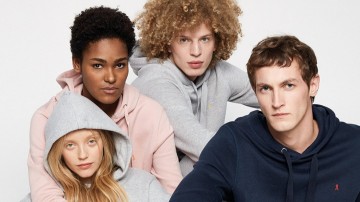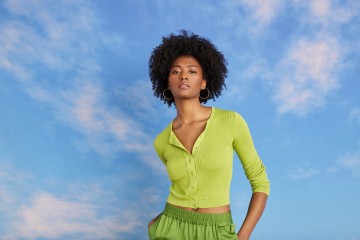Sustainability
Sustainability Series: ARMEDANGELS

At Otrium, we believe all clothing should be worn. We’re on a mission to eliminate unsold inventory and change the way clothing is created and sold.
11 JANUARY 2022
On our journey towards a smarter fashion industry, we’ve teamed up with Good On You – the leading source for fashion brand sustainability ratings.
Using their know-how, we can now highlight brands that are going above and beyond to make a positive impact, and label them as Sustainable; allowing our customers to make more informed choices. To celebrate, we’ve been chatting to Sustainable-rated brands on our platform to find out their take on being conscious as a company, and more.
We spoke to Lavinia Muth, former Corporate Responsibility lead at ARMEDANGELS. The Cologne-based brand not only makes fabulous fashion but is also here to make a positive impact. Here’s what Lavinia had to say:
What does sustainability mean to you?
“Well, personally I believe that sustainability is not enough – because it does not fix what’s broken. We need to think about more intelligent and more regenerative systems.
At ARMEDANGELS, we define a sustainable product as follows: a product is sustainable if the used materials intend to sustain the status-quo and do no further harm to the people and the planet. We define a product to be sustainable if it contains at least 95% of alternative materials defined in the ARMEDANGELS Material Guidelines.”
Tell us a little more about ARMEDANGELS.
“Founded in 2007 by two students, at the time, with the aim to actually produce and sell organic and fairly traded shorts in an ethical way. We started with a bottom-up approach, which worked out. Now, 14 years later, we are 129 passionate employees. We also do denim, knits, wovens, underwear, and more. We are GOTS and GRS certified, have joined the Fair Wear Foundation, have founded our own organic farmers' association in India with more than 505 farmers and we are on our way to responsibly implement circular business models. There’s more to come, so stay tuned!”
What is your role within ARMEDANGELS?
“I do Corporate Responsibility, which means that I implement social and ecological standard requirements at product-level and in supply chains. I also work closely with the top management, advocating for a fairer and more just fashion world, and for questioning our current business model.”
What’s been your journey to helping ARMEDANGELS create a positive impact?
“My background is Economics, Supply Chain Management, and Business Ethics, and I started working in the textile world 12 years ago. I am an accredited auditor and an in-your-face advocate for social and environmental justice, but my true dedication is more on the interfaces of business and human rights.”
What achievement makes you most proud?
“Our direct-to-grower approach within our work of the ARMEDANGELS Organic Farmers Association in India.”
And what are you working on at the moment?
“Defining corporate strategies, processes and new impact systems is my current daily routine. It’s super-exciting, although I prefer fieldwork where I can actively make a difference.”
What’s the best feedback you have ever received from customers?
“Authenticity, credibility, honesty, and humbleness. I think humbleness is my preferred one, a truly important characteristic!”
What do customers value most about ARMEDANGELS and your products?
“That we stick to our principles and always evolve. We try to do better, and if we know better, we do better.”
Where do you think the brand will be in five years?
“I would love to see a change in the business model – I wish to see more repairs, more care, more community creation, and more activism.”
What does the future of fashion look like to you?
“I wish to see more diversity, more inclusivity, and less doing business-as-usual.”
How do you stay optimistic and persistent in the fight against climate change?
“By telling people what the actual challenges are and also the solutions. It is not about using a renewable straw or cutting plastic bags. It is the moving-of-the-masses. It is calling out CEOs and politicians, a collective approach, and collective energy. That’s what keeps me persistent.”
What’s a recent change you have made to be more sustainable?
“Well, this might sound crazy, but I am learning to knit socks which I can repair myself.
Do you have a pro tip for extending the lifecycle of your wardrobe?
“Yes, and it’s super-easy! Follow the care instructions on the care label and try to fix and repair your clothing yourself. We can do this!”
Thanks for chatting with us, Lavinia!
More from Otrium
See all articles
Sustainability
How to look after your clothes.
We’re on an ongoing journey to make fashion smarter, giving fashion-lovers the best possible online retail experience and making sure every item of clothing is worn. Going forward, we decided to communicate more about our roadmap and responsible choices to be as transparent as possible.Fashion is one of the world’s most polluting industries and, unfortunately, 12% of the garments that are produced stay unsold.Our purpose is: All clothing should be worn.We’re tech-enabling designer brands to find an owner for every item they produce.In this post, we’ve got you covered with 10 easy tips to care for your clothes properly. Why’s this so important?Smarter for your wardrobe
Caring for clothes prolongs the life of your wardrobe keeping you in style for longer. – It will also save you time in the long run!Approximately 25% of a garment’s environmental footprint happens in the wearing and washing.So with our smart tips and tricks, you can maximise your wardrobe and be kinder to the planet.1. Wear it more, wash less
Only wash as needed. Washing after one use is often more out of habit than hygiene. Many garments just need to be aired out and stains can often be spot treated. Be responsible and have fewer laundry days – it’s a win-win.2. A lower temperature still gets the job done
Washing machines and detergents are developed to clean at a lower temperature than back in the day. Heat can break textile fibres down and it uses more energy so choose a cooler setting and enjoy your clothes for longer.3. Fill it up
Unless it is an emergency, a single garment on a full program of multiple cycles is a waste of both water and energy. Wait till you have enough laundry to fill the machine ¾. Don’t overfill your washing machine though as this prevents the water from flushing away the dirt and will result in less clean clothes.4. Skip the dryer
Just like it’s better to let your hair dry naturally, it’s better to let clothes air dry too! It keeps your garments in better nick and can even save you time ironing if you do it correctly. Use hangers for shirts and tailored pieces to ensure they dry crisp.5. Tackle stains the minute you spot them
If you get a stain on your new look, try to spot treat it immediately, it’s easier. Especially for natural materials such as cotton, linen and wool, which absorb a lot, making it harder to treat the stain if it’s too soaked in.6. Freeze your denim
Bagging and putting your denim in the freezer for a day or two keeps jeans in better shape and kills bacteria and odours. Is there room next to the ice cream?7. Sun’s out, shirt’s out
The sun has natural bleaching qualities when it comes to clothing. Hang your white clothes out to dry in the sunshine and take advantage of the natural bleaching.8. Dry wool garments flat
Knits love a flat surface when drying, it helps keep their shape, especially the heavier ones. So dry flat – preferably on a towel to absorb any extra moisture.9. Only iron if you have to
Need another excuse to get out of the ironing? Hang drying instead of tumble drying skips the energy cost of heating and running an iron. If your clothes are already clean and dry, hang them in your bathroom when you shower. The moist air will act a bit like a steamer, helping to reduce the creases.10. Brush up on skills
A missing button or a small defect doesn’t mean you have to throw clothes away. It’s just part of any product's natural life cycle and can easily be repaired to extend the life of your clothes. Pinterest, YouTube or TikTok are your friends offering helpful DIY advice. If you're not feeling crafty, there’s always a more practical loved one or an amazing tailor around the corner.All good things come to an end, including clothes. But with these 10 easy tips, you’ll be able to enjoy your clothes for much longer.If you need something new, undefined.#WearIt

Sustainability
Sustainability Series: adidas
If you’re familiar with Otrium, you’ll know by now that we believe all clothing should be worn. We’re on a mission to eliminate unsold inventory and change the way clothing is created and sold. And on our journey towards a smarter fashion industry, we’ve teamed up with Good On You – the leading source for fashion brand sustainability ratings. Using their expert know-how, Otrium can highlight brands that are more sustainable. We label these brands as Sustainable, which allows our customers to make more informed choices when they shop. To celebrate our Good On You collaboration, we’ve been chatting to Sustainable-rated brands on our platform. Today is also Earth Day, so what better time to speak to a global name like adidas to find out their take on sustainability and more? Here’s what adidas is doing to pioneer changes for the better.Sustainability: what does it mean to adidas?
Sustainability is part of our core belief: through sport we have the power to change lives. Sustainability, for us, is an ongoing process. We have always been involved in it and we have always worked on this topic, through the BCI Cotton Initiative, Work Labour Agreement and more. We want to provide the best sports gear using the best sustainable option available.Tell us more about adidas…
The adidas brand has a long history and deep-rooted connection with sport. Its broad and diverse portfolio in both the Sport Performance and Sport Inspired categories ranges from major global sports to regional grassroot events plus local sneaker culture. This has enabled adidas to transcend cultures and become one of the most recognized, credible and iconic brands both on and off the field of play.We believe that through sports we have the power to change lives. We will always strive to expand the limits of human possibilities, to include and unite people in sport, and to create a more sustainable world. Where did the brand’s sustainable journey begin?
Our sustainability journey began in the 1990s, becoming a member of the Fair Labor Association – an organization that helps to improve the lives of millions of workers around the world. In 2000, all our products became PVC-free and we created the first 100% recyclable performance shoe in 2019. See the timeline below for our other milestones in becoming more sustainable:What achievement are you most proud of?
Back in 2015, adidas was the first brand to create a shoe made of ocean plastic with Parley (an organization that addresses major threats towards the ocean and works with collaborators to raise awareness and action projects to help end destruction). Tell us about your ‘End Plastic Waste’ mission and how it helps adidas solve this global problem?
We want to offer more sustainable options to our consumers by designing products made with recycled plastic or in partnership with other companies and organizations (such as Parley, above), as well as items that can be recycled, to stop them ending up in landfills. How do you envision using circular techniques to help mitigate the negative impact of plastic waste and pollution?
We plan to give consumers the option to return products that they no longer use to be either re-worked or recycled. Made To Be Remade is our current line made from recycled materials, and each piece can be recycled again at the end of its life.The objective is to be a platform with items made from sustainably sourced materials and to have more options for recycling old products and reducing waste. We’re also working on a new program for even more circular services. Does Otrium’s circular model help you to reach your targets with this mission?
Yes, for sure. Being more circular is key to help end plastic waste. For us, that’s giving consumers more opportunities to buy recycled products and finding more solutions for older items to be reused and repurposed.What else are you working on at the moment?
We want to develop more and more. We are working to make sure we achieve our commitment to make 9 out of 10 items more sustainably by 2025. We look for new innovations, we push our customers, and we bring forward communication to support our consumer on what we can do together.What is the biggest challenge on the roadmap of improvements?
Sustainability is a long journey, and we need to really put in the effort to bring this forward. We not only want to change what adidas does, but how our industry acts towards sustainability at large. We face challenges every day to find the best materials and the best way to resonate with consumers.What do customers value most about adidas and its products?
adidas is a strong sports brand and we’re here to bring the best for the athlete. For us, “Impossible is Nothing” and we carry this value with us to really strengthen our sustainability journey.Where do you see adidas in 5 years?
adidas wants to be the leader of sustainability in our industry. By 2025, 9 out of 10 items in our range will be made sustainably, and we will also stop using virgin polyester wherever possible (by 2024). Besides which, we want to be a more circular company as a whole by then. Do you think that through changing the historical fashion industry framework, we can achieve a reduction in plastic waste?
What we need to do is to change the industry. adidas has been working and investing in sustainability for years. We want to set an example, learn from our partners and keep fostering the change. If we lead, others will follow. By helping consumers be more sustainable, our mission to help end plastic waste will keep on going. What does the future of fashion look like?
Consumers are looking for more circularity. The fashion industry needs to adapt to introduce products that last longer, and can be recycled or have their lifecycle extended, so we can make sure we are not creating more waste. This is what people want and we need to provide the solutions. Amazing work. Thanks for chatting to us, adidas.

Sustainability
We are (officially) fur free
We’re on a journey to make fashion smarter, giving fashion-lovers the best possible online retail experience and making sure every item of clothing is worn. Going forward, we’ll be sharing more about our conscious roadmap and responsible choices.Throughout the fashion industry, 12% of the garments that are produced stay unsold.Our purpose is: All Clothing Should Be Worn.We’re tech-enabling designer brands to find an owner for every item they produce.In this post, we’ll be sharing why we became a member of the Fur Free Retailer program, what this means and how you can join this movement to be fur free.The definition of furFirst things first: Fur means any animal skin or part of an animal with hair or fur fibres attached, either in its raw or processed state or the pelt of any animal killed for the animal‘s fur.What is not fur, and what we will keep selling:undefinedundefinedundefinedIntroducing the policyWe recently became an official member of The Fur Free Retailer program, which is supported by the Fur Free Alliance (FFA) – an international coalition of leading animal and environmental protection organisations worldwide.In a nutshell: An international effort to give consumers accurate information about a retailer’s fur policy, allowing consumers to make an informed choice when shopping.From a day-to-day perspective our platform will stay the same, as we currently do not have any garments that contain fur. Having this accreditation makes this official – for our customers and for our partners.We have chosen to sell leather and other animal derived materials – but not the pelt of any animal killed for the animal‘s fur. As more vegan alternatives, innovations and products come to market we will continuously reassess our policy regarding animal-derived materials like leather.Becoming fur free is a first small step of our journey, with the goal of having a positive impact on the fashion industry.Sustainable brands at OtriumWe’re always on the lookout for Sustainable brands so if there’s a brand you love for their sustainability credentials that you feel we should be featuring please reach out to undefined.How can you be fur freeWhen purchasing a garment with faux fur, check the points below to be sure you’re not wearing real fur. Sometimes, faux fur is being substituted for real fur by some manufacturers. You can follow these four checkpoints:undefinedundefinedundefinedundefinedundefined.
Subscribe to Our Newsletter
Get the newest discounts, brands, and drops.
Otrium
Customer service
Customer service
© 2016-2025 Otrium, except certain content provided by third parties
